The History of St. Nicholas, Santa Claus & Father Christmas
The Man Behind the Story of Father Christmas/Santa Claus
St. Nicholas was a Bishop who lived in the fourth century, in a place called Myra in Asia Minor (now called Turkey). He was a very rich man because his parents died when he was young and left him a lot of money. He was also a very kind man and had a reputation for helping the poor and giving secret gifts to people who needed it. There are several legends about St. Nicholas, although we don't know if any of them are true!
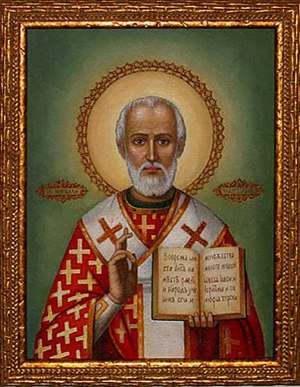
www.stnicholascenter.org
The most famous story about St. Nicholas tells how the custom of hanging up stockings to put presents in first started! It goes like this:
There was a poor man who had three daughters. The man was so poor that he did not have enough money for a dowry, so his daughters couldn't get married. (A dowry is a sum of money paid to the bridegroom by the bride's parents on the wedding day. This still happens in some countries, even today.) One night, Nicholas secretly dropped a bag of gold down the chimney and into the house (this meant that the oldest daughter was then able to be married). The bag fell into a stocking that had been hung by the fire to dry! This was repeated later with the second daughter. Finally, determined to discover the person who had given him the money, the father secretly hid by the fire every evening until he caught Nicholas dropping in a bag of gold. Nicholas begged the man to not tell anyone what he had done, because he did not want to bring attention to himself. But soon the news got out and when anyone received a secret gift, it was thought that maybe it was from Nicholas.
Because of his kindness Nicholas was made a Saint. St. Nicholas is not only the saint of children but also of sailors! One story tells of him helping some sailors that were caught in a bad storm off the coast of Turkey. The storm was raging around them and all the men were terrified that their ship would sink beneath the giant waves. They prayed to St. Nicholas to help them. Suddenly, he was standing on the deck before them. He ordered the sea to be calm, the storm died away, and they were able to sail their ship safely to port.
St. Nicholas was exiled from Myra and later put in prison during the persecution of Christians by the Emperor Diocletian but he was released in the time of the later Emperor Constantine, who was a Christian. Some records show St Nicholas attending the Council of Nicaea in 325 (where things about Christianity were discussed). However, many scholars now think that St Nicholas wasn't at the Council of Nicaea and might have been added to lists of people at the council many years later as by then he was 'famous'.
No one is really knows when St Nicholas died, it was on 6th December in either 343 (which seems to be the most probable), 345 or 352. In 1087, his bones were stolen from Turkey by some Italian merchant sailors. The bones are now kept in the Church named after him in the Italian port of Bari. On St. Nicholas feast day (6th December), the sailors of Bari still carry his statue from the Cathedral out to sea, so that he can bless the waters and so give them safe voyages throughout the year.
in 1066, before he set sail to England, William the Conqueror prayed to St. Nicholas asking that his conquest would go well.
You can find out lots about St Nicholas at the St. Nicholas Center (goes to another site).
How St. Nicholas Became Santa Claus
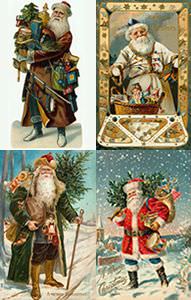
In the 16th Century in northern Europe, after the reformation, the stories and traditions about St. Nicholas became unpopular.
But someone had to deliver presents to children at Christmas, so in the UK, particularly in England, he became 'St Christmas', 'Father Christmas' or 'Old Man Christmas', an old character from story plays during the middle ages in the UK and parts of northern Europe. In France, he was then known as 'Père Nöel'.
In some countries including parts of Austria and Germany, the present giver became the 'Christkind' or 'Christkindl' a golden-haired baby (or sometimes a young girl), with wings, who symbolizes the new born baby Jesus.
Many countries, especially ones in Europe, celebrate St. Nicholas' Day on 6th December. In The Netherlands and some other European Countries, children leave clogs or shoes out (rather than a stocking) on the 5th December (St. Nicholas Eve) to be filled with presents. They also believe that if they leave some hay and carrots in their shoes for Sinterklaas's horse, they will be left some sweets.
Dutch settlers to the USA took the stories of St. Nicholas or 'Sinterklaas', as he'd come to be known in parts of northern Europe, with them.
Over time the celebration of Sinterklaas died out in the early USA. However, St. Nicholas became popular again in the early 1800s when writers, poets and artists, such as Washington Irving, rediscovered the old Dutch stories about St Nicholas. In their new and re-worked stories and St Nicholas / Sinterklaas became 'Santa Claus'!
German settlers to the USA also brought their stories of the Christkindl who became known as 'Kris Kringle'. As Sinterklaas became known as Santa Claus, the name Kris Kringle was added as another name for Santa!
In 1821 an anonymous poem called 'Old Santeclaus with Much Delight' was published in New York. The poem was published with eight illustrations in a book called 'The Children's Friend: A New-Year's Present, to the Little Ones from Five to Twelve'. It's the earliest images of 'Santa Claus' rather than St Nicholas or Sinterklaas and the first time that Santa/St Nicholas was seen in a sleigh being pulled by a reindeer.
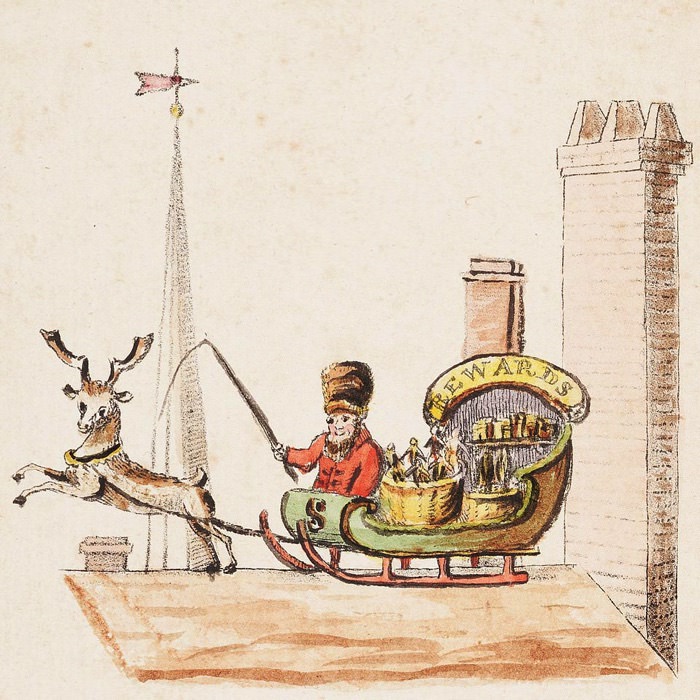
In 1823 the famous poem 'A Visit from St. Nicholas' or 'Twas the night before Christmas', was published. The poem was first published anonymously, in the Troy Sentinel (a town in New York state) and was originally titled "Account of a Visit from St. Nicholas". Dr Clement Clarke Moore later claimed that he had written it for his children. Some scholars now believe that it was actually written by Henry Livingston, Jr., who was a distant relative of Dr Moore's wife.
In the poem, St. Nicholas is described "He was chubby and plump, a right jolly old elf" and as coming with "a miniature sleigh and eight tiny rein-deer". This was the first time we found out the names of the reindeer. In 2022 a Hallmark Christmas movie was produced called "Twas the Night Before Christmas". It's set in Troy and the plot is about a play debating who wrote the poem. (No spoilers!)
These are the original eight reindeer that were described in the poem 'A Visit from St. Nicholas':
- Dasher
- Dancer
- Prancer
- Vixen
- Comet
- Cupid
- Donner (who's also been called Dunder and Donder)
- Blitzen (who's also been called Blixem, Blixen and Blicksem)
In 1939 we first learnt about Rudolph, when he was written about in a book by Robert L May for the Montgomery Ward department stores. Rudolph then had a cartoon made about him in 1948 and the famous song 'Rudolph the Red nosed Reindeer' was written in 1949.
In 1902 the author L. Frank Baum (who wrote the Wizard of OZ) wrote a book called 'The Life and Adventures of Santa Claus'. In it a team of 10 reindeer are listed. They have rhyming names in pairs: Flossie and Glossie, Racer and Pacer, Fearless and Peerless, Ready and Steady, Feckless and Speckless. In different books, TV shows, films and songs, other reindeers have been named. Perhaps these are the reverse teams!
Did you know that Rudolph and Santa's other reindeers might well be all girls!? Only female reindeer keep their antlers throughout winter. By Christmas time most males have discarded their antlers and are saving their energy ready to grow a new pair in the spring.
The UK Father Christmas and the American Santa Claus became more and more alike over the years and are now one and the same.
Some people say that Santa lives at the North Pole. In Finland, they say that he lives in the north part of their country called Lapland.
But everyone agrees that he travels through the sky on a sledge that is pulled by reindeer, that he comes into houses down the chimney at night and places presents for the children in socks or bags by their beds, in front of the family Christmas tree, or by the fire place.

Most children receive their presents on Christmas Eve night or early Christmas morning, but in some countries they get their presents on St. Nicholas' Eve, December 5th.
St. Nicholas putting the bags of gold into a stocking is also where the custom of having a tangerine or satsuma (types of small citrus fruits like small oranges) and often some nuts at the bottom of Christmas stocking. If people couldn't afford gold coins, some golden fruit was a good replacement! Until the last 50/60 years fruits like tangerines or satsumas were quite unusual and special, especially in Europe.
St Nicholas is also the patron saint of pawnbrokers and their sign of three gold balls comes from the story of St Nicholas giving three bags of gold.
Now it's more common to find chocolate coins at the bottom of a Christmas stocking, rather than real coins or a tangerine or satsuma!
The biggest Christmas stocking was 51m 35cm (168ft 5.65in) long and 21m 63cm (70ft 11.57in) wide (from the heel to the toe). It was made by the volunteer emergency services organisation Pubblica Assistenza Carrara e Sezioni (Italy) in Carrara, Tuscany, Italy, on 5th January 2011. Just think how many presents you could fit in that!
In 1897 an eight year old girl wrote to a newspaper asking about Santa. The paper wrote a reply which is now famous and known as 'Yes, Virginia, there is a Santa Claus'.
Santa Claus and Coca-Cola
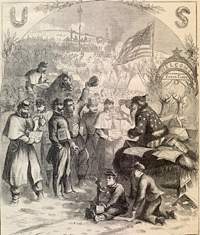
There's a Christmas Urban Legend that says that Santa's red suit was designed by Coca-Cola and that they might even 'own' Santa!
This is definitely NOT TRUE!
Long before coke had been invented, St Nicholas had worn his Bishop's red robes. During Victorian times and before that, he wore a range of colors (red, green, blue and brown fur) but red was always his favorite! (Images of 'St Christmas', 'Father Christmas' and 'Old Man Christmas' often had him wearing a green 'open' robe trimmed with white. This was also the inspiration for 'The Ghost of Christmas Present' in Charles Dickens 'A Christmas Carol'.)
In January 1863, the magazine Harper's Weekly published the first illustration of St Nicholas/St Nick by Thomas Nast. In this he was wearing a 'Stars and Stripes' outfit! Over the next 20 years Thomas Nast continued to draw Santa every Christmas and his works were very popular indeed (he must have been very good friends with Santa to get such good access!).
This is when Santa really started to develop his big tummy and the style of red and white outfit he wears today. Nast designed Santa's look on some historical information about Santa and the poem 'A Visit from St. Nicholas' and the illustrations from 'Old Santeclaus with Much Delight'.
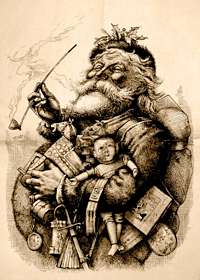
On January 1st 1881, Harper's Weekly published Nast's most famous image of Santa, complete with a big red belly, an arm full of toys and smoking a pipe!
This image of Santa became very popular, with more artists drawing Santa in his red and white costume from 1900 to 1930.
Santa was first used in Coke adverts in the 1931, with the classic 'Coke Santa' being drawn by artist Haddon Sundblom. He took the idea of Nast's Santa but made him even more larger than life and jolly, replaced the pipe with a glass of Coke and created the famous Coke holding Santa!
Coca-Cola also agree that the red suit was made popular by Thomas Nast and not them!
Coke has continued to use Santa in their adverts since the 1931. In 1995 they also introduced the 'Coca-Cola Christmas truck' in the 'Holidays are coming' TV adverts. The red truck, covered with lights and with the classic 'Coke Santa' on its sides is now a famous part of recent Christmas history.
Santa Claus in Department Stores
Macy's Store in New York claims to be the first store to have Santa visit them in 1861/1862. This was only a few years after the store was founded. From 1924, the arrival of Santa became the finale of the Macy's Thanksgiving Parade. The Macy's Santa became extra famous after being in 1947 film Miracle of 34th Street.
James Wood Parkinson from Philadelphia is sometimes said to have been the first person to have Santa visit their store. In the 1840s Santa entertained people visiting his confectionary shop.
The person we know to be 'one of Santa's helpers' was James Edgar who portrayed Santa in his dry goods store in Brockton, Massachusetts in 1890. James Edgar was born in Edinburgh, Scotland in 1843 and moved to Brockton in 1878. In the years before he started playing Santa, he'd been running July 4th picnics for several thousand local children and would dress up as different figures at the picnics. Soon after the first appearance of Santa in his store, children from Boston and even New York were travelling to see him!
By the 1920s, the Department Store Santa had become a fixture in the US and then throughout the world.
Last Updated: | Sources Information